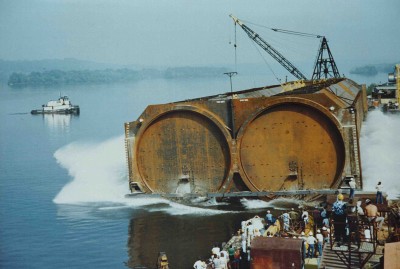Fort McHenry Tunnel
HEIGHT: 12.7 m
WIDTH: 25.1 m
TOTAL IMMERSED LENGTH: 1,646 m
DEPTH AT BOTTOM OF STRUCTURE: 31.7 m
ENVIRONMENTAL CONDITIONS: Very mild currents and tidal conditions, except for storm effect. Flow of bottom sediment was a problem affecting several elements. Three elements required rescreeding.
FABRICATION METHOD: Shipyard at Port Deposit, Maryland about 65 km from tunnel site. Uncontrolled side launch.
WIDTH: 25.1 m
TOTAL IMMERSED LENGTH: 1,646 m
DEPTH AT BOTTOM OF STRUCTURE: 31.7 m
ENVIRONMENTAL CONDITIONS: Very mild currents and tidal conditions, except for storm effect. Flow of bottom sediment was a problem affecting several elements. Three elements required rescreeding.
FABRICATION METHOD: Shipyard at Port Deposit, Maryland about 65 km from tunnel site. Uncontrolled side launch.
Baltimore, Maryland,
United States

Interstate Division Baltimore City (IDBC)
Joint Venture: Peter Kiewit & Sons Inc, Raymond International Inc and Tidewater Construction Corp
Joint Venture: Sverdrup Corporation and Parsons Brinckerhoff Quade and Douglas Inc
104.8m
1,646m
31.7m
Project construction
1987-05-01
32 (16 elements for each tunnel)
Two parallel tunnels, each with two tubes and two lanes in each tube, for a total of eight traffic lanes.
12.7m
25.1m
Two parallel immersed tunnels, only 3 m apart, mostly on a curve. Overall largest
vehicular immersed tunnel project in the world. Elements were placed alternately from
the northbound tunnel to the southbound tunnel. An 11 m deep ship wharf was removed
during construction and later replaced as a float-in caisson on top of the twin tunnel.
Scheduling of element placement depended on the relocation of a 122 cm critical city
watermain, which crossed the alignment. This relocation involved a deep cofferdam in
the middle of the river, to make the changeover. First use of remotely controlled wedges
for horizontal alignment adjustment.
vehicular immersed tunnel project in the world. Elements were placed alternately from
the northbound tunnel to the southbound tunnel. An 11 m deep ship wharf was removed
during construction and later replaced as a float-in caisson on top of the twin tunnel.
Scheduling of element placement depended on the relocation of a 122 cm critical city
watermain, which crossed the alignment. This relocation involved a deep cofferdam in
the middle of the river, to make the changeover. First use of remotely controlled wedges
for horizontal alignment adjustment.
Shipyard at Port Deposit, Maryland about 65 km from
tunnel site. Uncontrolled side launch.
tunnel site. Uncontrolled side launch.
OUTFITTING:
At dockside in Baltimore, 70
km. from the site. Up to six
elements were being
outfitted at one time.
At dockside in Baltimore, 70
km. from the site. Up to six
elements were being
outfitted at one time.
Very mild currents and tidal conditions, except for storm effect. Flow of bottom sediment
was a problem affecting several elements. Three elements required rescreeding.
was a problem affecting several elements. Three elements required rescreeding.
Catamaran barge system.
Double rubber gasket.
Welded, grouted liner plate.
Welded, grouted liner plate.
Continuous steel shell
Option was provided for either jetted sand or screeded bedding. The contractor opted
for the screeded method. A special taut moored rig was used, with the flotation tanks
fully submerged to prevent tidal effects.
for the screeded method. A special taut moored rig was used, with the flotation tanks
fully submerged to prevent tidal effects.
1.5 m of ordinary backfill














